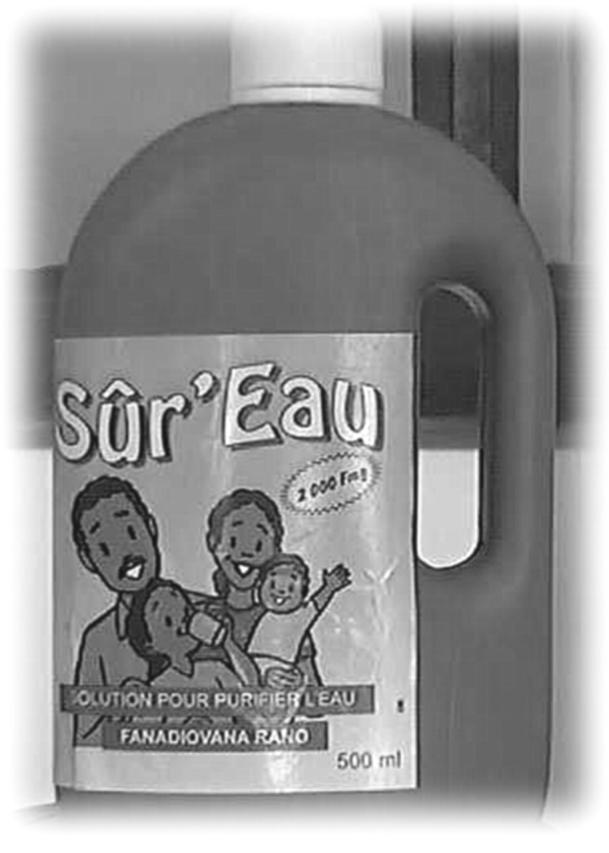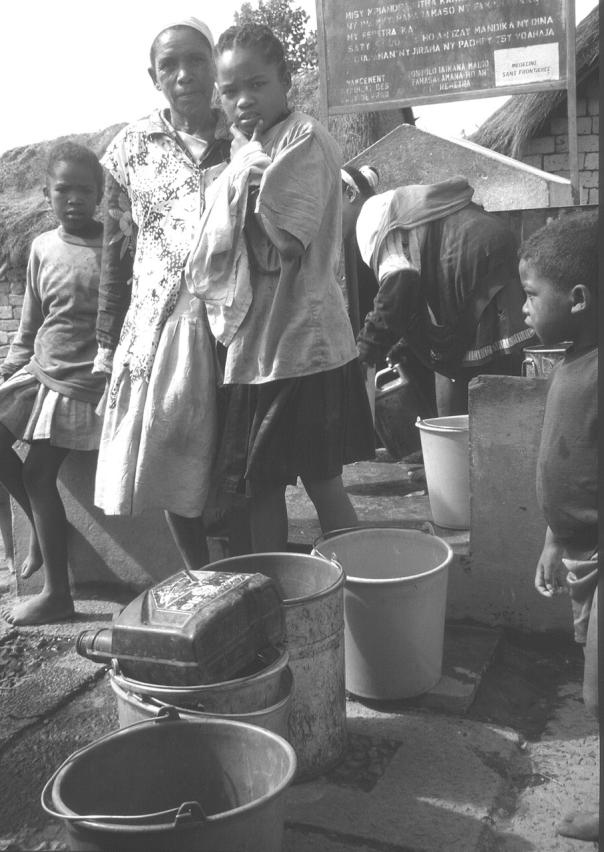Abstract
Cyclone Hudah struck the northeastern coast of Madagascar in the spring of 2000. Over a 5-month period, 11 700 relief kits consisting of bottles of water disinfectant and foldable jerry cans were distributed to the affected population. Five months after the cyclone, a survey was conducted in 12 villages to determine the impact of these relief kits on water quality.
Seventy-six percent of the surveyed households reported using jerry cans, and 65% reported using the disinfectant. Stored water in households using both products had significantly less microbiological contamination than stored water in other households. To improve the prospects for a sustainable intervention, the response plan for future disasters should incorporate a transition to recovery and development, including formative research into local customs, beliefs, and water handling habits, and funding support to initiate social marketing.
ON APRIL 2, 2000, CYCLONE Hudah made landfall along the northeastern coast of Madagascar. Winds of up to 300 km/h (190 miles/h) and flooding caused major damage to infrastructure, cash crops, and food crops. A rapid assessment conducted from April 3 to April 8 revealed 111 deaths and identified injuries, malaria, and diarrhea as the main cyclone-associated health problems (Comité Restreint Interventions aux Catastrophe, Madagascar, unpublished data, 2000).
On April 5, CARE Madagascar, in response to the need for potable water,1 deployed the Safe Water System, which consists of behavior change techniques and point-of-use treatment and safe storage of water.2 The system was already being socially marketed by Population Services International to 68 villages in Antalaha, the district most affected by the cyclone. Relief kits consisting of Sûr'Eau water disinfectant and Reliance foldable 5-gallon jerry cans (Reliance Industries Ltd, Mumbai, India) were distributed, and the population was educated about the use of these products.
The first consignment was limited to 1800 relief kits because unusually high demand for Sûr'Eau engendered by a concurrent cholera epidemic resulted in a shortage of the product. The second consignment, consisting of 4500 relief kits, was delayed until May 24 because of a lack of boats available for shipping. In total, 11 700 kits were distributed between April 13 and August 14. In addition, 63 villages that had received earlier supplies of Sûr'Eau were provided with 7600 supplementary bottles.
PROGRAM MONITORING AND EVALUATION
To measure the impact of the Safe Water System in cycloneaffected communities, we conducted a survey of water quality and water storage and treatment practices in a convenience sample of 12 villages in September 2000. For logistic reasons, the survey was limited to village centers within 50 m of the main roads, an area that included an estimated 1500 households. We randomly sampled 123 households to obtain an estimate with a margin of error of ±5% and a confidence level of 95%. The N,N-diethyl-phenylenediamine colorimetric method (Hach Co, Loveland, Colo) was used to test drinking water stored in households for free and total chlorine residuals. The membrane filtration technique3 was used to test source and stored drinking water for contamination with Escherichia coli.
DISCUSSION AND EVALUATION
Five months after the cyclone and deployment of the Safe Water System, 76% of surveyed households reported using jerry cans and 43% were observed using them for drinking water storage; 91% reported ever using Sûr'Eau and 65% indicated current use (Table 1 ▶). Reasons for attrition in use of the Safe Water System may have included cultural habits such as consumption of rice water (water heated in cooking pots with rice residue) in the seasonally cool weather and limited awareness that the Safe Water System can prevent illness. The disparity between reported (76%) and observed (43%) use of jerry cans could be explained by the difficulty of emptying water from the flexible jerry cans. In addition, the jerry can was not highly valued. In contrast, the median price that people were willing to pay for Sûr'Eau was more than the commercial price of 2000 Malagasy francs (US $0.33).
TABLE 1—
Water Storage and Treatment Practices, Water Quality, and Prices That People Were Willing to Pay for Jerry Cans and Sûr'Eau Disinfectant in Cyclone-Affected Communities: Antalaha, Madagascar, September 2000
| No. | % | |
| Water storage | ||
| Jerry can received | 94/123 | 76 |
| Jerry can in use | 93/123 | 76 |
| Water observed in jerry can | 40/93 | 43 |
| Water treatment | ||
| Ever used Sûr'Eau | 105/123 | 85 |
| Sûr'Eau in use | 80/123 | 65 |
| Boiling as alternative to treatment | 100/123 | 81 |
| Water testing | ||
| Detectable total chlorine residuals | 31/40 | 78 |
| Free chlorine > 0.2 mg/L | 18/40 | 45 |
| Free chlorine > 3.5 mg/L | 6/40 | 15 |
| Opinion of Safe Water System | ||
| Use of jerry can prevents diarrhea/cholera | 23/93 | 25 |
| Use of Sûr'Eau prevents diarrhea/cholera | 32/105 | 31 |
| Prices People Were Willing to Pay | |||
| Median | Range | ||
| Note. FMG = Malagasy francs. | |||
| Jerry can | FMG 7500 ($1.15) | FMG 2500–50 000 ($0.38–7.69) | |
| Sur'Eau | FMG 2500 ($0.38) | FMG 500–10 000 ($0.08–1.54) | |
Free chlorine residuals greater than 0.2 mg/L were found in almost half of the water samples tested, indicating that Sûr'Eau was in fact being used; none of the surveyed households that used a bucket were chlorinating their water. Some water samples showed free chlorine levels of more than 3.5 mg/L, which could result in a strong taste; these households were likely using a higher dose of Sûr'Eau than was recommended at the time of the evaluation. High turbidity in source water following the cyclone required double the usual chlorine dose for adequate treatment, but by the time of the evaluation the water had cleared, reducing chlorine demand and permitting use of a lower dose.
Water samples from 43 buckets, 40 jerry cans, and 4 other household containers were tested for contamination with E coli. The median number of E coli colonies per 100 mL was significantly lower in jerry cans (0, range 0–200) than in buckets (13, range 0–200) (P = .005).
At the time of this evaluation, although a program of recovery (e.g., rebuilding houses and roads) was well under way, the disaster response program of free distribution of Sûr'Eau, which would be unsustainable in the long term, had continued. A plan for socially marketing Sûr'Eau had been developed, but funding was initially unavailable. An interruption in the supply of Sûr'Eau was averted after the evaluation as a result of funding obtained to expand the Sûr'Eau social marketing project to this and other regions.
NEXT STEPS
In future disaster situations, programming a portion of disaster response funds for a transition to recovery and development with a realistic time schedule may improve prospects for sustaining an intervention. The likelihood of success would be enhanced by conducting formative research into local water handling customs and beliefs about disease transmission and incorporating the findings into the project.4 Funding support to initiate widely accessible social marketing should be part of the disaster response. Education about the Safe Water System would need to address dosing instructions for different water turbidity conditions.
Although this evaluation was conducted 5 months after the cyclone and was limited to a small number of communities that may not have been representative of the whole affected area, our findings suggest that the Safe Water System is a useful intervention that can be rapidly mobilized and distributed in disaster situations. Assessments conducted immediately after implementation in disaster situations will be able to further illuminate the utility of this intervention and provide a basis for improving implementation strategies.
HIGHLIGHTS
• CARE Madagascar and Population Services International collaborated to deploy a socially marketed, household-based safe water intervention in the aftermath of Cyclone Hudah.
• Use of a water disinfectant solution and storage in jerry cans significantly lessened microbiological contamination of household water supplies.
• In the future, a portion of disaster response funding should be programmed for transition to recovery and development activities.
Figure 2.

Figure 1.

Malagasies with typical storage containers waiting in line for water at a public tap.
Acknowledgments
Y. Mong wrote the paper and contributed to conception and design of the study and to data analysis and interpretation. R. Kaiser analyzed the data, assisted in writing the paper, and contributed to conception and design of the study. D. Ibrahim contributed to conception and design of the study and reviewed the manuscript. Rasoatiana participated in design and data collection and reviewed the manuscript. L. Razafimbololona contributed to conception and design of the study, to data analysis and interpretation, and to writing the paper. R. E. Quick participated in the design, data collection, data analysis, and writing of the manuscript.
Resources for this research were provided by the R. W. Woodruff Foundation to CARE and the CDC Foundation, as part of the CARE–CDC Health Initiative.
The authors are grateful to Patricia Riley, Dr Luke Nkinsi, Reema Jossy, and Lori Buhi for their support. We wish to thank Sabine Holihasinoro Andriaman-dimbisoa and Patrick Rakotozanany of CARE Madagascar and Benjamina Ramananjaonina and Christine Ravonizafy of the Centre National de Recherches sur l'Environnement for their conscientious fieldwork in this evaluation. We are grateful to the communities in this survey for their gracious collaboration with the field teams.
Peer Reviewed
Note. Use of trade names is for identification only and does not constitute endorsement by the Centers for Disease Control and Prevention or by the Department of Health and Human Services.
Resources
For further information regarding this work, visit http://www.cdc.gov/safewater.
References
- 1.Lillibridge SR. Managing the environmental health aspects of disasters: water, human excreta, and shelter. In: Noji E, ed. The Public Health Consequences of Disasters. New York, NY: Oxford University Press; 1997:65–78.
- 2.Safe Water Systems for the Developing World: A Handbook for Implementing Household-Based Water Treatment and Safe Storage Projects. Atlanta, Ga: Centers for Disease Control and Prevention; 2000. Also available at: http://www.cdc.gov/safewater. Accessed July 3, 2001.
- 3.Mates A, Shaffer M. Membrane filtration differentiation of E. coli from coliforms in the examination of water. J Appl Bacteriol. 1989;67:343–346. [DOI] [PubMed] [Google Scholar]
- 4.Stanton B, Black R, Engle P, Pelto G. Theory-driven behavioral intervention research for the control of diarrheal diseases. Soc Sci Med. 1992;35:1405– 1420. [DOI] [PubMed] [Google Scholar]


